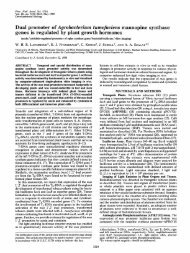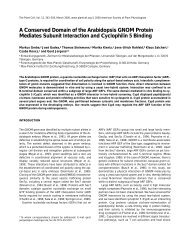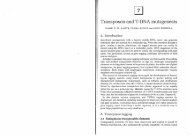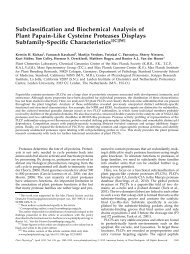Plasma membrane calcium ATPases are important components of ...
Plasma membrane calcium ATPases are important components of ...
Plasma membrane calcium ATPases are important components of ...
You also want an ePaper? Increase the reach of your titles
YUMPU automatically turns print PDFs into web optimized ePapers that Google loves.
Frei dit Frey et al.12345678910111213141516171819202122232425262728293031323334To further overcome limitations <strong>of</strong> BiFC assays we performed Förster ResonanceEnergy Transfer (FRET) measurements on the basis <strong>of</strong> Fluorescence Lifetime ImagingMicroscopy (FLIM) using respective FLS2 and ACA8 fusions to CFP or YFP. FRET can bedetected using FLIM where reduction <strong>of</strong> the fluorescence lifetime <strong>of</strong> a donor-containingmolecule occurs due to proximity <strong>of</strong> an acceptor-containing molecule, which is an indication<strong>of</strong> physical interaction. We examined FLS2-ACA8 association in protoplasts from soil-grownArabidopsis plants. Under this condition we observed a significant reduction in fluorescencelifetime when FLS2-CFP and ACA8-YFP were co-expressed as comp<strong>are</strong>d to the fluorescencelifetime <strong>of</strong> ACA8-CFP alone (Figure 1B; Table S1). Similar results were obtained when weused FLS2-CFP and ACA8-YFP. This suggests that both proteins <strong>are</strong> in close proximity toeach other, indicative <strong>of</strong> protein-protein interaction. Interaction <strong>of</strong> fluorophore-tagged FLS2and ACA8 was detected at the plasma <strong>membrane</strong>, which is in line with the subcellularlocalization <strong>of</strong> the two proteins and substantiates our findings <strong>of</strong> BiFC in N. benthamiana.However, interaction <strong>of</strong> fluorophore-tagged FLS2 and ACA8 was not distributed uniformlyacross the plasma <strong>membrane</strong>, but seen as patchy <strong>are</strong>as with strongly reduced fluorescencelifetimes (Figure 1B), which indicates the presence <strong>of</strong> FLS2-ACA8 complexes were restrictedto subdomains within the plasma <strong>membrane</strong>. This observation is in agreement with the notionthat FLS2 and ACA8 can localize to flg22-induced plasma <strong>membrane</strong> microdomains (Keinathet al., 2010). Despite numerous attempts we failed to clone a full-length ACA10 cDNA, whichprecluded analysis <strong>of</strong> ACA10 by fluorophore-based interaction assays. Despite poor resultsby co-immunoprecipitation analysis, pull-down experiments <strong>of</strong> FLS2-GFP followed by massspectrometricanalysis repeatedly revealed presence <strong>of</strong> ACA8 and ACA10 peptides, furthercorroborating the existence <strong>of</strong> FLS2-ACA8 and FLS2-ACA10 complexes in planta (FigureS2). Taken together, these results indicate that FLS2 forms a complex with ACA8 at theplasma <strong>membrane</strong>, and ACA8 can interact with multiple RKs, pointing at an <strong>important</strong> role inthe regulation <strong>of</strong> RK-mediated signalling pathways.ACA8 and ACA10 exhibit partial overlapping functionsTo address ACA8 function, we isolated a T-DNA insertion line and a tilling mutant(both in Col-0 genetic background) in the ACA8 gene (Fig. S1B). Genetic redundancy withinmembers <strong>of</strong> the ACA family has been documented, and could be expected for members <strong>of</strong> theACA8, ACA9, ACA10 subgroup (Boursiac and Harper, 2007). Because ACA9 expression wasspecific to pollen tubes, we focussed on ACA10, isolated a T-DNA insertion line in theACA10 gene, and generated aca8 aca10 double knock-out lines (Figure S1C). In addition, we6






